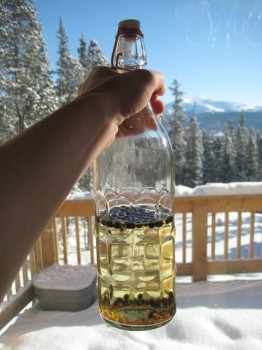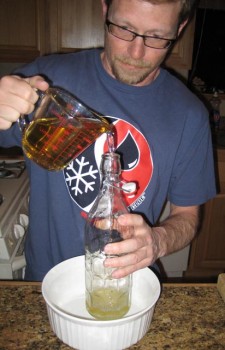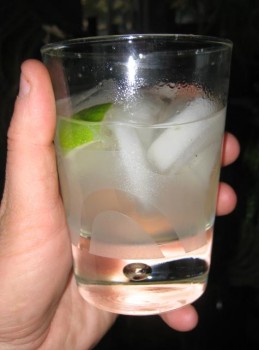
Perhaps one day I’ll get into distilling my own spirits, but until that day comes, I did find a lazy’s man’s gin recipe on Ehow that involves wild edible plants.
According to the website of the now-defunct Gin & Vodka Association, gin flavorings (referred to as botanicals) include juniper as the mandatory and dominant flavor, in addition to any or all of the following: coriander, angelica, orange peel, lemon peel, cardamom, cinnamon, grains of paradise, cubeb berries, and nutmeg. Additional gin botanicals are listed at Tony Ackland’s site on the home distillation of alcohol.
The wild edible plant I used in my gin is juniper, of course. We have tons of it growing in the back yard and I’ve collected juniper “berries” (which aren’t berries at all, but rather cones) on numerous occasions, so I have a collection of these dry, hand-picked “berries” in the closet. (Another botanical on the list—angelica—also grows in parts nearby, but I have yet to positively identify and harvest any on account of the similarities it bears to poison hemlock and water hemlock, both of which are highly toxic. So, I’m biding my time until I’m 100% positive about angelica.)

“Typically a fine gin contains six to ten botanicals,” states the Gin & Vodka Association’s website. I would say mine is less of a “fine” gin and more of a “bathtub” gin, which Wikipedia defines “as any style of homemade spirit made in amateur conditions.” As such, I used only two botanicals—juniper and coriander—and I made the gin simply by flavoring vodka.
The only differences between my approach and the Ehow instructions for How to Make Gin from Juniper Berries were that I halved the recipe, crushed the “berries” in addition to the coriander, and didn’t bother to clarify it using a water filtration system. Thus my gin, which steeped for 6 or 7 days before Gregg strained out the botanicals, is yellow in color.

When it comes to gin (or any other spirits for that matter), neither Gregg nor I have a very sophisticated palette. “It smells like gin,” Gregg said, sniffing the bottle. “And I can taste the juniper,” he added after trying it.
Since then, we’ve enjoyed quite a few yummy gin and tonics with a splash of lime, and unless anyone comes over here to tell us any different, we’ll keep drinking it and be none the wiser!
UPDATE 7.23.11: I changed the wording on what I said about angelica above. The entry originally said it grows in “lower elevations” nearby–which it does, but it also grows at 10,500 feet, where I found some the other day. So I deleted the “lower elevations” comment and will blog at length on my angelica find shortly.

Oh how cool. I’ve been meaning to do this. Actually, what I want to do is make a strong juniper-flavored syrup or tincture, to flavor soda. I love a good G&T, but sometimes I just want that wonderful flavor to quench my thirst. After a hot day in the sun, nothing is more refreshing, but it can make my head spin. So I wanted to flavor my tonic water with juniper for a non-alcoholic G&T soda for those days when head spinniness is not optimal.
By the by, have you made bitters? I’ve been making them for a couple of years now and they are fabulous and easy. You can throw in everything but the kitchen sink and after they’ve aged a bit, they get swoony-wonderful.
http://www.flickr.com/photos/50728681@N06/5462553943/
@Ellen: OMG I totally want to make syrup too. How on earth would you do that? (Gregg’s here in the background saying he can’t think of any time that head spinniness is not optimal, hah.) And honestly if I weren’t a tad spinny myself at the moment I’d say more, but for now: Your pictures are absolutely gorgeous. I’ve never made bitters b4 but now I want to.
PS: Thanks for the nice compliment on the other entry about zee blog.